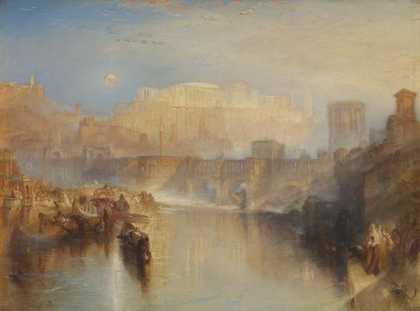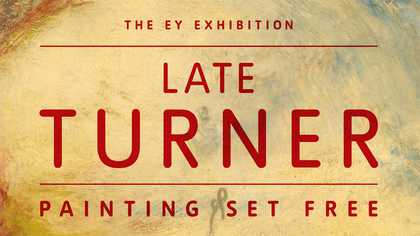
Joseph Mallord William Turner
Ancient Rome; Agrippina Landing with the Ashes of Germanicus (exhibited 1839)
Tate
10 September 2014 – 25 January 2015 (Press view 8 September)
Admission £15 (£13.10 concessions) or £16.50 (£14.50 concessions) with Gift Aid donation
Tate Britain, Linbury Galleries
For public information call +44 (0)20 7887 8888, visit tate.org.uk, follow @tate #LateTurner
The EY Exhibition: Late Turner – Painting Set Free will be the first major exhibition to survey the achievements of J.M.W. Turner (1775–1851) during his final period (1835–50). The exhibition will reassess Turner’s extraordinary body of work during this period, when some of his most celebrated works were created, and opens at Tate Britain on 10 September.
The exhibition will begin in 1835, the year that Turner reached 60, and will close with his last exhibits at the Royal Academy in 1850. It will demonstrate how his closing years were a time of exceptional energy and vigour, initiated by one of his most extensive tours of Europe. Bringing together 150 works from the UK and abroad, it will seek to challenge assumptions around the idea of the ‘elderly’ artist, as well as his radical techniques, processes and materials during this productive time.
The show will include such iconic works as Ancient Rome; Agrippina Landing with the Ashes of Germanicus exh. 1839 (Tate), The Wreck Buoy 1849 (National Museums Liverpool) and Heidelberg: Sunset c.1840 (Manchester City Galleries). Rather than focusing on any assumptions about the pessimism of old age, Turner maintained his commitment to the observation of nature. He brought renewed energy to the exploration of the social, technological and scientific developments of modern life, in works such as Rain, Steam, and Speed – The Great Western Railway 1844 (National Gallery). He also continued to engage with the religious and historical themes that linked him to the cultural traditions of his era.
Featuring many large-scale oil paintings alongside drawings, prints and watercolour, the exhibition will address the sheer range of materials and techniques he embraced. It will also demonstrate his radicalism during this period - while his Victorian contemporaries were exploring other priorities, he continued to champion an unfettered creativity in which material practice was not just medium but meaning and message too. He consciously developed his style and technique with each subsequent painting he produced. These works were often poised equivocally between finished and unfinished, for example in a series of reworkings in oil of subjects originally published as prints in his Liber Studiorum.
During his final period Turner continued to widen his exposure in the marketplace. From pictures of the whaling industry in the 1840s to ‘sample studies’ and finished watercolours such as The Blue Rigi, Sunrise 1842 (Tate), he constantly sought to demonstrate his appeal to new admirers, led by John Ruskin who famously described Turner as ‘the greatest of the age.’
Joseph Mallord William Turner (1775–1851) was born in London, the son of a barber. He entered the Royal Academy Schools in 1789 at the age of 14 before becoming a member of the RA in 1802 and Professor of Perspective in 1807. His work was prolific and varied including drawings, prints, watercolours and oils. Throughout his later years he continued to tour Europe, his last trip taking pace in 1845. He exhibited his last four pictures at the Royal Academy in 1850 and died in 1851, his body being laid to rest in the crypt of St Paul’s Cathedral.
The EY Exhibition: Late Turner – Painting Set Free is curated by Sam Smiles, Professor of Art History and Visual Culture, Exeter University, and David Blayney Brown, Manton Curator of British Art 1790–1850, Tate Britain with Amy Concannon, Assistant Curator 1790–1850, Tate Britain, the exhibition will be accompanied by a fully illustrated catalogue from Tate Publishing and a programme of talks and events in the gallery. J.M.W. Turner: Painting Set Free will show at the J. Paul Getty Museum Los Angeles, USA (24 February – 24 May 2015) and to the de Young Museum, San Francisco, USA in 2015 (20 June – 20 September 2015).
Late Turner is the second EY Exhibition in a three-year arts partnership between EY and Tate. The first exhibition was Klee which ran at Tate Modern from 14 October 2013 to 9 March 2014. The partnership helps Tate to realise its ambitious arts programme across Tate Modern and Tate Britain, with EY’s support being extended through corporate memberships at Tate Liverpool, Tate St Ives and at many of the Plus Tate partners around the country. The partnership, announced in July 2013 makes EY one of the largest corporate supporters of Tate.
Martin Cook, Managing Partner Commercial, UK & Ireland at EY, said:
Turner was not only a compulsive artist, who had to draw and paint all the time, but he was also complex, with some of his iconic work considered controversial and radical for his time. We are delighted that Late Turner is the second EY exhibition as part of the arts partnership between EY and Tate. This unique relationship is an example of how EY teams with other organisations that share our purpose and builds on our previous support of Turner exhibitions in 2003 and 2005.

